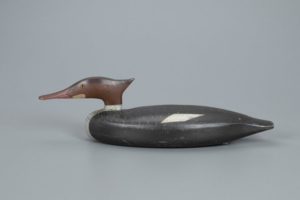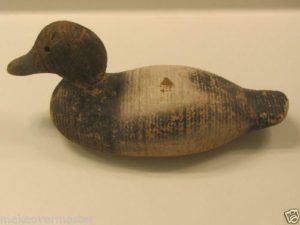A Decoy Corner Article
By Bruce Urben, President
This month’s Decoy Corner column strays a little from my usual articles highlighting a carver and showcasing his life and style. Since beginning this project, I have received numerous calls, texts, emails and visits from our members and non-members alike, asking about their old decoys, who may have made them and what the value might be. Very few collectors will say that they are an expert about vintage decoys! Yes, there are and were some very seasoned collectors out there, none more knowledgeable than Joel Barber (Wildfowl Decoys, 1965) or William Mackey, Jr. (American Bird Decoys, 1965), who had each collected decoys for over 70 years. Don’t get me wrong, there are some current collectors who have seen, held, and researched carvings and carvers from all over the world. There are also a number of auction houses with knowledgeable staff, specializing in only vintage decoys, like Guyette & Deeter, Frank & Frank and Copley Fine Art, to name a few.
Most collectors of decoys are waterfowl hunters that appreciate the heritage of waterfowling past with vintage decoys made of wood, cork or canvas. There are also collectors that have never waterfowl hunted that appreciate the art’s form and function. Collectors collect because they see the beauty of, recall the use of, or are taken with the nostalgia of antique pieces.
Decoy collecting was coined by Joel Barber (the father of decoy collecting) back in the 1900’s, well before it was in vogue. People say that the decoy collecting heyday was in the 1960’s through the 1970’s when wood decoys were phasing out for the lighter plastic models. I can attest to that as that’s when I first caught the decoy collecting bug!
Today, there seems to be a resurgence of decoy collecting, and not just on the highly recognized, well known carvers. Factory decoys like Mason, Evan and Animal Trap are also becoming scarce and difficult to find. And, many seasoned waterfowlers are going back to hunting over wood decoys, sometimes to reminisce days gone by!
So… what should a collector focus on for their collecting process? I will try to list a number of items that our past and present collectors seem to agree on.
- Determine what you like to collect and collect them. Narrow your collecting to the carver, style, locale or flyway that you like.
- Try to collect quality decoys over quantity! Define what you are collecting. Factory decoys, a favorite carver from your area, specific species or construction method. Original paint or working repaint… it’s what you like.
- Consider vintage decoys and current contemporary carver’s work. Current carver’s work is very affordable and these will be similar to what Mackey and Barber collected in the 1900’s!
- Is it for your collection or for investment? We can’t all collect $10,000 decoys – but, $2.00 decoys collected in 1910 certainly have shown a high ROI. The same is true for decoys carved in the 2000’s that you can keep for 75 years. Set your limits.
- Once you have a collection, how do you maintain it? Try to refrain from fixing or touching up a vintage decoy; it may lose its value unless it is done by a professional.
- Avoid oiling, varnishing or treating your antique decoy. Experts recommend cleaning with a damp cloth or, at most, light waxing with a quality furniture wax.
- Protect your collection from UV light or high humidity areas.
- Keep records of your collection. The provenance, or “history”, of each decoy is valuable and should be recorded for the next owner of the decoy. We all wish our old decoys could tell us when they were made and who owned them, but many times you see “carver unknown”.
- Protect your decoy collection with insurance. Many decoys may be irreplaceable to you, however, many homeowner policies have a very affordable fine arts policy you should consider.
- Lastly and most important: enjoy what you collect. Many have told me it’s not the collecting but the people you meet during the collecting that is just as important. Sometimes the old “derelict” decoy by an unknown carver can give you fond memories of your past waterfowling adventures, or fill that void until the next season arrives!
Good Collecting…
Bruce


